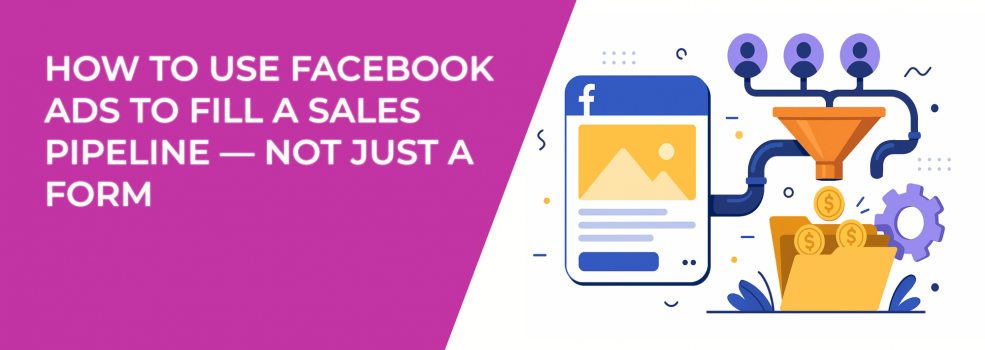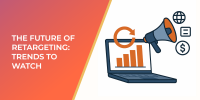Most advertisers know how to generate leads with Facebook Ads. Fewer know how to turn those leads into pipeline opportunities that sales teams can close. A full spreadsheet of names is useless if 90% of them never answer an email, don’t have budget authority, or simply aren’t ready to buy.
The smarter play is to design ad campaigns that move people through a real buying journey. That means qualifying, educating, and nurturing them until they’re ready for a sales conversation.
Here’s how to transform Facebook Ads into a pipeline engine — not just a form-fill machine.
Go Beyond the Lead Form
A form is the entry point, not the destination. Optimizing only for the lowest cost per lead (CPL) will quickly flood your CRM with unqualified contacts.
Advanced strategies to raise quality:
-
Dynamic form logic. Use conditional questions in Facebook Instant Forms to separate serious buyers from casual browsers.
-
Progressive disclosure. Start with easy questions on the ad form, then qualify deeper through automated emails or surveys.
-
Value-driven offers. Replace generic “Get a free quote” CTAs with higher-intent magnets such as “ROI calculator,” “Industry benchmarking report,” or “30-day trial access.”
These subtle changes set a higher bar for entry, ensuring your pipeline fills with stronger leads.
Map Ads to Pipeline Stages With Precision
Most advertisers loosely follow “top, middle, bottom” funnels. But advanced marketers create campaigns that mirror each pipeline stage exactly.
-
Awareness → MQL (marketing qualified lead): Ads promoting webinars, guides, or explainer videos.
-
MQL → SQL (sales qualified lead): Retargeting ads with case studies, testimonials, or proof-of-results videos.
-
SQL → Opportunity: Ads offering demos, trials, or discounts tied to urgency.
-
Opportunity → Closed deal: Reminder ads about contracts, onboarding steps, or implementation perks.
When campaigns are sequenced this way, Facebook Ads don’t just generate clicks — they actively move deals forward.
For a deeper dive into structuring full-funnel campaigns, check out our article on Facebook Ads Funnel Strategy: From Audience Identification to Conversion. It explains how to connect ads across every stage of the customer journey.
Qualify and Score Leads Before They Hit Sales
Advanced advertisers treat Facebook Ads as the first filter in lead scoring. Not all form-fills deserve a rep’s time.
Practical tactics:
-
Assign points based on form answers (e.g., company size, role, budget).
-
Use engagement history (video views, page visits, ad clicks) as part of a lead scoring model.
-
Sync Facebook Ads directly to your CRM or marketing automation platform for real-time scoring.
This prevents your sales team from chasing low-fit leads and prioritizes those closest to purchase intent.
Audience building is where many advertisers slip up. Our piece on How to Define a Target Audience for Marketing: a Step-by-Step Guide walks through creating profiles that actually match your pipeline needs.
Sync Ads With Sales Enablement
A gap often exists between ads and sales conversations. Fixing that gap makes a huge difference.
-
Ad-to-script alignment. Sales reps should reference the exact ad or offer a lead responded to.
-
Custom audiences for reps. Build audiences of each rep’s leads and run personalized nurture ads alongside their outreach.
-
Deal-stage retargeting. If a deal is stuck in “negotiation,” run ads highlighting ROI, competitor comparisons, or limited-time bonuses.
This tight alignment ensures Facebook Ads actively support the sales process instead of just feeding it.
Optimize for Pipeline Health, Not Volume
Instead of reporting on CPL, advanced marketers evaluate pipeline efficiency.
-
Cost per opportunity (CPO): How much ad spend it takes to generate one sales-qualified opportunity.
-
Pipeline velocity: The average time from first click to closed deal.
-
Deal size by source: Which campaigns produce the most profitable customers, not just the most leads.
-
Lifetime value (LTV) lift: Whether certain campaigns attract longer-retention customers.
By optimizing around these, you stop scaling campaigns that inflate lead volume but drain sales resources.
If you want to dig into smarter optimization tactics, our article on How to Analyze Facebook Ad Performance Beyond CTR and CPC shows you how to measure what really drives revenue.
Layer Retargeting as a Pipeline Accelerator
Retargeting shouldn’t stop at “people who clicked.” Use it as a pipeline acceleration tool.
-
Serve ads with ROI proof to decision-makers who downloaded your whitepaper but haven’t booked a call.
-
Run explainer videos only to people who watched at least 50% of your previous video.
-
Target deal-stage audiences with urgency offers, like “Sign this month and unlock onboarding credits.”
This keeps your brand top of mind and helps eliminate bottlenecks in the pipeline.
We’ve covered more advanced retargeting setups in Retargeting vs. Broad Targeting: Which Strategy Drives Better Results, which can help you decide when to narrow focus or go wider.
Advanced Strategy: Multi-Channel Sequencing
Your leads don’t live in one channel. Combining Facebook Ads with other touchpoints multiplies effectiveness.
-
Facebook + Email: Follow up a webinar ad with a 3-step email nurture, then retarget opens with testimonial ads.
-
Facebook + LinkedIn: Target broad audiences on Facebook, then retarget decision-makers on LinkedIn with higher-value offers.
-
Facebook + SMS: After form submissions, deliver instant reminders by SMS while Facebook runs nurture ads.
This creates an ecosystem where each channel reinforces the others, driving faster progression through the pipeline.
Advanced Strategy: Predictive Targeting
Facebook’s algorithm is powerful, but you can make it sharper by feeding it predictive signals.
-
Upload custom audiences of closed-won customers and let Facebook find lookalikes.
-
Suppress audiences of “closed-lost” deals to reduce wasted spend.
-
Test AI-based tools (outside Facebook) to identify accounts most likely to buy, then push those lists into Custom Audiences.
This ensures your ad spend focuses on prospects with the highest likelihood of becoming pipeline opportunities.
Final Thoughts
Form fills don’t grow a business — pipelines do. To transform Facebook Ads into a true revenue driver, marketers must:
-
Qualify and score leads before they hit sales.
-
Map ads directly to pipeline stages.
-
Sync campaigns with sales enablement.
-
Measure pipeline health with advanced metrics.
-
Use retargeting, sequencing, and predictive targeting to accelerate deals.
When you stop chasing cheap leads and start engineering a buyer journey, Facebook Ads shift from a cost center into a scalable growth engine.
Ask yourself this: would you rather brag about low CPL, or celebrate consistent closed deals fueled by your ad campaigns? The answer determines how you build your next campaign.

